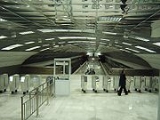
Novosibirsk Metro
Encyclopedia
History


Siberia
Siberia is an extensive region constituting almost all of Northern Asia. Comprising the central and eastern portion of the Russian Federation, it was part of the Soviet Union from its beginning, as its predecessor states, the Tsardom of Russia and the Russian Empire, conquered it during the 16th...
, the Trans-Siberian railway
Trans-Siberian Railway
The Trans-Siberian Railway is a network of railways connecting Moscow with the Russian Far East and the Sea of Japan. It is the longest railway in the world...
and the Ob River
Ob River
The Ob River , also Obi, is a major river in western Siberia, Russia and is the world's seventh longest river. It is the westernmost of the three great Siberian rivers that flow into the Arctic Ocean .The Gulf of Ob is the world's longest estuary.-Names:The Ob is known to the Khanty people as the...
. Thus, it was not a surprise that the city grew very quickly. Plans for a rapid transit system
Public transport
Public transport is a shared passenger transportation service which is available for use by the general public, as distinct from modes such as taxicab, car pooling or hired buses which are not shared by strangers without private arrangement.Public transport modes include buses, trolleybuses, trams...
began to be formed in the late 1960s and on the May 12, 1979 the first construction works began. With wide experience in metro construction from the other metro
Rapid transit
A rapid transit, underground, subway, elevated railway, metro or metropolitan railway system is an electric passenger railway in an urban area with a high capacity and frequency, and grade separation from other traffic. Rapid transit systems are typically located either in underground tunnels or on...
s of the USSR, it took seven and a half years to complete work on the five-station launch stage of the system which was triumphantly opened on January 7, 1986, becoming the eleventh Metro in the USSR and the fourth in Russia.

Facts
The system contains 13 stations on two lines. There are 80 carriages that form 20 four-carriage trains which carry over 250,000 passengers daily. The stations are vividly decorated in late-Soviet style. Currently, of the 13 stations (12 station plus the interchange station counted twice), seven are pillar-trispan, four are single vaults. There is also a surface level station which follows a 2.145 km covered bridge span of the Ob RiverOb River
The Ob River , also Obi, is a major river in western Siberia, Russia and is the world's seventh longest river. It is the westernmost of the three great Siberian rivers that flow into the Arctic Ocean .The Gulf of Ob is the world's longest estuary.-Names:The Ob is known to the Khanty people as the...
.
Lines
| # | Name | Opened | Newest station added | Length | Stations |
|---|---|---|---|---|---|
| 1 | Leninskaya Leninskaya Line Leninskaya Line , is a line of the Novosibirsk Metro. The line was opened along with the Metro in 1986 with the original five station segment. Since then it slowly expanded. The line bisects the city of a Northwest-Southeast axis before making a 90 degree turn and crossing the river Ob river on a... |
1986 | 1992 | 10.5 km | 8 |
| 2 | Dzerzhinskaya Dzerzhinskaya Line Dzerzhinskaya Line is a line of the Novosibirsk Metro. The history of the line begins with the original Metro design plan, which despite numerous attempts could not make a provision to include the central railway terminal, something crucial for the Metro to become the city's main artery... |
1987 | 2010 | 5.86 km | 5 |
| Total | 16.36 km | 13 | |||

